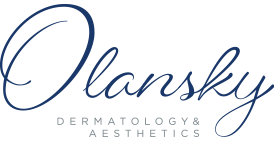There are several reasons to keep an eye on your nail care, but freedom from unsightly (and potentially painful) nail fungus is a big one.
At Olansky Dermatology & Aesthetics we are here to help you find the best form of treatment.
Nail Fungus Symptoms and Causes
Nail fungus may start as a small yellow patch on your nail but will become dark, dull and even painful over time. If left untreated, your nail may even start to emit a foul odor or begin to separate from the nail bed.
The American Academy of Dermatology Association adds that nails suffering from fungal infection may show a change in texture, such as becoming brittle, dry, or even crumbly.
There are a variety of possible causes for a fungal nail infection, including genetic heredity, previous peripheral vascular disease, or repeated nail injury.
In general, the fungal infection is caused by exposure to a specific yeast or dermatophyte usually found in warm, moist environments like inside your socks and shoes, or in swimming pools or showers. A previous case of athlete’s foot could also be the source of infection. Manicure and pedicure tools can spread the fungus if they are not properly sanitized.
Getting Rid of Nail Fungus
The sooner you see a specialist and consult them about treatment, the better. Depending on the severity of your condition — and other health factors — here are the different options that may be recommended.
Oral antifungal drugs
Because toenails grow slowly, it may take 6-12 weeks (or even as long as four months) for these medications to treat your infection. Though you won’t see full improvement until the healthy nail grows back completely, oral drugs such as terbinafine (Lamisil) or itraconazole (Sporanox) are popular because they are the fastest acting.
While taking these medications, some patients may experience side effects, so your doctor may request occasional blood tests to monitor your health while you’re being treated.
Medicated “nail polish”
Though painting the infected nails and surrounding skin may sound like fun, experts at the Mayo Clinic predict that doing so with the medicine ciclopirox (Penlac) could take almost a year to yield results for 5.5 to 8.5 percent of those using the treatment. Two newer nail lacquers — tavaborole (Kerydin) and efinaconazole (Jublia) — cleared up fungal infections in approximately the same time period for 6.5 – 17.8 percent of users, according to Consumer Reports.
Other Alternatives
While creams, soaks, soaps and ointments won’t cure nail fungus infections, they may be useful for relieving your itching, discomfort, and potentially embarrassing changes in nail coloration or texture. Verywell Health recommends Terbinafine Hydrochloride AntiFungal Cream, and Fungi Nail Antifungal Ointment, among other effective aids.
In extremely painful and debilitating conditions, your health specialist may recommend surgery to remove the affected nail and the growing fungus beneath. While extremely effective, it is also expensive and can be painful.
Though laser treatment for nail fungus has gained popular attention, there is limited reliable research regarding its true efficacy.
The best way to treat nail fungus may be to avoid it altogether. Here are some recommended steps for prevention:
- Choose shoes and socks of materials that breathe, and change them out frequently
- Wash your feet and hands regularly
- Trim your toenails straight across, and disinfect your tools
- Wear flip-flops, shower sandals, or other foot coverings in pools and communal showers
No matter the condition of your toes, consultation with a skin and nail specialist will help bring them to optimal health. If you suspect the beginnings of toenail fungus (or know you are firmly in the throes of an infection), Olansky Dermatology & Aesthetics can provide personalized care for you. Let us help you find happy feet by scheduling an appointment with us online or calling (404) 355-5484.


